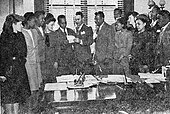Southern Negro Youth Congress
| Southern Negro Youth Congress | |
|---|---|

Members of the Southern Negro Youth Congress Meet with Idaho Senator Glen Taylor
|
The Southern Negro Youth Congress was established in 1937 at a conference in Richmond, Virginia. The Southern Negro Youth Congress consisted of young leaders that participated in the National Negro Congress. The first gathering of the Southern Negro Youth Congress consisted of a wide range of individuals. Such individuals as representatives from almost all the black colleges in the country, Boy and Girl Scouts, young steel workers, and even members of the YMCA all joined together to form the Southern Negro Youth Congress.
The Southern Negro Youth Congress felt that the major threat to the role of democracy was not communism or socialism but rather fascism was the biggest threat, not only to the black population but also a major threat to the white population as well. Many members of the Southern Negro Youth Congress felt that it was a great organization because it allowed people to not only settle into the Southern areas but also take action to change it for the better as well.
The Southern Negro Youth Congress engaged in many activities during the late 1930s and 1940s such as leading boycotts against discriminatory working environments, registering African-American votes, discussed problems with government officials in Washington, D.C., organized workers into unions and assisted rural African-Americans in legal cases. The Southern Negro Youth Congress performed such studies as taking items being purchased in a black community and then comparing the prices to those same items being purchased in a white community. This study showed that prices for the same goods were 20-30% higher in the black communities then they were in the white communities, which meant that the citizens who were struggling most to survive were actually paying higher prices for the items that were necessary for them to live.
Prominent members of the Southern Negro Youth Congress consisted of veteran activists James Jackson, Helen Gray, Esther Cooper Jackson and Edward E. Strong and at one time or another had the support of prominent figures that included Mary McCleod Bethune, Charlotte Hawkins Brown, Franklin D. Roosevelt and William Edward Burghardt DuBois. At its prime the Southern Negro Youth Congress claimed that it represented about 250,000 young black southerners but due to insufficient records these numbers could not be verified. The Southern Negro Youth Congress saw its demise in 1949 in part due to the postwar period of the United States caught in the Cold War as well as fear, hysteria, racial violence and loss of jobs that led to many difficulties for the Southern Negro Youth Congress leaders to solve.
...
Wikipedia
